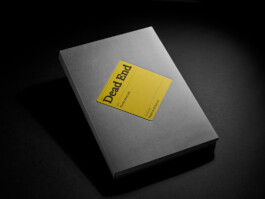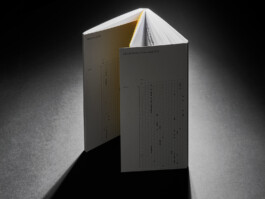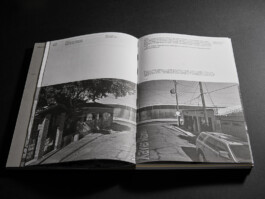Nicola Moscelli. An Archeo-Visual Journey Along the U.S.–Mexico Border
02.11.2025, 4:30 pm
Among the many human constructs, the border is certainly one of the most impactful on the life of communities and on the very demarcation of the earth’s geography. The one between the United States and Mexico is paradigmatic, and therefore widely documented, explored by both cinema and photography. Nicola Moscelli’s book Dead End seeks to observe it differently. How? By intersecting the arbitrary, spatial perspective of street view—the gaze of “Pegman”—with other material trajectories (historical and literary, for instance) that expand its definition.
The border is not merely a superficial or administrative line, but a living fabric interwoven with relationships that enrich its texture and deepen its understanding. The book itself is designed to embrace this reciprocity, allowing the reader to cross the border at will. Dead End, “vicolo cieco,” bears its title. There are thousands of such “streets” that end abruptly. Moscelli has mapped many of them, all sharing the aftertaste of an interrupted story, of suspended magic, of meaning lost in nothingness. He restores their perspective through textual incursions, quotations, and reflections. The vision is further enriched by contributions from Maceo Montoya, Miriam Ticktin, and Steve Bisson.
This investigation opens onto a method that appropriates visual relics and computational residues to reframe the border as an interpretive, conceptual, and optical device. Welcome to a new “scopic” archaeology that employs images as fossils of social memory.

Nicola Moscelli, Dead End, Penisola Edizioni/Antiga Edizioni

Nicola Moscelli, Dead End, Penisola Edizioni/Antiga Edizioni

Nicola Moscelli, Dead End, Penisola Edizioni/Antiga Edizioni
Nicola Moscelli (Taranto, 1980) is an engineer and documentary photographer. He uses photography and the visual arts to spark awareness, understanding, and debate about the environment and the ways in which humanity relates to or intervenes in it. He currently lives in The Hague, the Netherlands.
Working with his own photographs and archival material, he develops visual narratives focused on the anthropological investigation of the environment, understood in its identity dimensions and in its historical and cultural legacies. With the publication Dead End, he won the Fedrigoni Top Award 2025 and was shortlisted for the Aperture–Paris Photo Photobook Awards 2024, the FotoFabbrica Prize at DieciXDieci Festival, the PhotoEspaña Award 2025, and the Rencontres d’Arles Book Prize 2025.
Nicola Moscelli. An Archeo-Visual Journey Along the U.S.–Mexico Border
02.11.2025, 4:30 pm
Among the many human constructs, the border is certainly one of the most impactful on the life of communities and on the very demarcation of the earth’s geography. The one between the United States and Mexico is paradigmatic, and therefore widely documented, explored by both cinema and photography. Nicola Moscelli’s book Dead End seeks to observe it differently. How? By intersecting the arbitrary, spatial perspective of street view—the gaze of “Pegman”—with other material trajectories (historical and literary, for instance) that expand its definition.
The border is not merely a superficial or administrative line, but a living fabric interwoven with relationships that enrich its texture and deepen its understanding. The book itself is designed to embrace this reciprocity, allowing the reader to cross the border at will. Dead End, “vicolo cieco,” bears its title. There are thousands of such “streets” that end abruptly. Moscelli has mapped many of them, all sharing the aftertaste of an interrupted story, of suspended magic, of meaning lost in nothingness. He restores their perspective through textual incursions, quotations, and reflections. The vision is further enriched by contributions from Maceo Montoya, Miriam Ticktin, and Steve Bisson.
This investigation opens onto a method that appropriates visual relics and computational residues to reframe the border as an interpretive, conceptual, and optical device. Welcome to a new “scopic” archaeology that employs images as fossils of social memory.

Nicola Moscelli, Dead End, Penisola Edizioni/Antiga Edizioni

Nicola Moscelli, Dead End, Penisola Edizioni/Antiga Edizioni

Nicola Moscelli, Dead End, Penisola Edizioni/Antiga Edizioni
Nicola Moscelli (Taranto, 1980) is an engineer and documentary photographer. He uses photography and the visual arts to spark awareness, understanding, and debate about the environment and the ways in which humanity relates to or intervenes in it. He currently lives in The Hague, the Netherlands.
Working with his own photographs and archival material, he develops visual narratives focused on the anthropological investigation of the environment, understood in its identity dimensions and in its historical and cultural legacies. With the publication Dead End, he won the Fedrigoni Top Award 2025 and was shortlisted for the Aperture–Paris Photo Photobook Awards 2024, the FotoFabbrica Prize at DieciXDieci Festival, the PhotoEspaña Award 2025, and the Rencontres d’Arles Book Prize 2025.